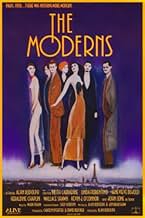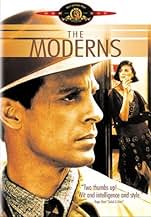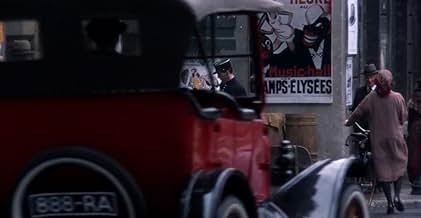AVALIAÇÃO DA IMDb
6,6/10
2,1 mil
SUA AVALIAÇÃO
Adicionar um enredo no seu idiomaA struggling artist is hired to forge paintings, causing him to cross paths with his ex-wife and her powerful new husband.A struggling artist is hired to forge paintings, causing him to cross paths with his ex-wife and her powerful new husband.A struggling artist is hired to forge paintings, causing him to cross paths with his ex-wife and her powerful new husband.
- Direção
- Roteiristas
- Artistas
- Prêmios
- 2 vitórias e 5 indicações no total
Geneviève Bujold
- Libby Valentin
- (as Genevieve Bujold)
Charlélie Couture
- L'Evidence
- (as Charlelie Couture)
Véronique Bellegarde
- Laurette
- (as Veronique Bellegarde)
- Direção
- Roteiristas
- Elenco e equipe completos
- Produção, bilheteria e muito mais no IMDbPro
Avaliações em destaque
This film is, first of all, a love story--but a remarkably surprising one, and by no means ordinary. It starts with the usual expectations most of us have about Paris that Woody Allen recently utilized so effectively in Midnight In Paris, but instead of broad comedy, Director Alan Rudolph weaves a fascinating tale of intrigue in the art world, and peppers it with wit and ambiguity.
The smoky Parisian ambiance of Bohemian Cafes (mostly created in Canada) introduce the viewer to Keith Carradine's stereotypical starving artist--except that Carradine's role is written to surprise, and one is drawn into a labyrinth of conflicting emotions very quickly indeed. This film, like Thieves Like Us, demonstrates what a fine under-utilized actor Carradine continues to be.
The feeling of elation that comes from escaping from one's cares in another place washes through every bar and café and art opening, and the performances from such vibrant actors as kinky Geraldine Chaplin and quirky Wallace Shawn--and especially the intensely cold and controlled and fascinating John Lone enliven the two hours that linger long after the film is finished.
The smoky Parisian ambiance of Bohemian Cafes (mostly created in Canada) introduce the viewer to Keith Carradine's stereotypical starving artist--except that Carradine's role is written to surprise, and one is drawn into a labyrinth of conflicting emotions very quickly indeed. This film, like Thieves Like Us, demonstrates what a fine under-utilized actor Carradine continues to be.
The feeling of elation that comes from escaping from one's cares in another place washes through every bar and café and art opening, and the performances from such vibrant actors as kinky Geraldine Chaplin and quirky Wallace Shawn--and especially the intensely cold and controlled and fascinating John Lone enliven the two hours that linger long after the film is finished.
I must admit Alan Rudolph's work is hard to either greatly admire or sternly criticize. He has become one of these directors, like David Cronenberg or Paul Verhooven, that some love and some despise. But, the reality is it is hard to know where such directors stand. I must say that my feeling that Rudolph's films were too much like his mentor Robert Altman's has been changed upon seeing "The Moderns." While I am a huge fan of Altman, it has been hard for me too admire directors that seem too merely imitate him. But, this film is much more surreal than anything that Altman has done, especially in recent years. The film also establishes a clear mood and setting. Rudolph also selects very solid shots throughout the film. If there has been one disadvantage of the cinema medium over stage, it is that the audience can not see an actor's immediate response to a given situation because the focus is on another character. But, here Rudolph lets you inside virtually each of the characters. The cast is also solid. Keith Carradine is at his best. It is a shame that he now apparently has to go to Iceland to find cinematic roles, but if one thinks Jeff Bridges is an underrated actor there is proof- at least in this film--- that Carradine has been overlooked even more. I also think Wallace Shawn is great here, which is amazing considering that I am NOT a fan of the film "My Dinner with Andre." And, lastly Mark Isham's score is brilliant in this film. It may not be a film for all tastes, and because of its simplistic nature it is understandable why this film gets lost in the shuffle when it comes to discussions about great films from the 80s. Nevertheless, I think it is a remarkable film if not for anything else it does prove that an American can make a great movie set in Paris, which is not a musical, even if it was (as this film was) shot in Montreal!
Nick Hart (Keith Carradine) is an ex-patriot American painter who lives in Paris in the 1920's. He picks up some money selling caricatures but is very poor. An art gallery owner, Libby (Genevieve Bujold) is sympathetic but can't muster up many sales for Nick's work. Now, a wealthy divorcée. Nathalie (Geraldine Chapman) commissions Nick to make copies of some expensive paintings, as a sort of plot against her ex-husband. Reluctantly, Nick agrees. Complicating matters further is the fact that when Nick frequents his favorite bar, which is quite often, he runs into a beautiful, beautiful woman named Rachel (Linda Fiorentino) who happens to be married to a rich American businessman, Bertram (John Lone). Wouldn't you know, Bertie is a sadist and controls Rachel with an iron fist. He loves to do things like shave under Rachel's arms with a straight razer! So, two things are paramount to Nick. Will he begin to sell his art and will he be able to win Rachel away from her husband? This is quite a lovely film with a very great cast. Carradine does a fine job as the main character while Fiorentino is extremely lovely and touching. But, its Lone who practically steals the show, with his terrifying turn as the bad, bad guy. Most everyone will appreciate the gorgeous sets, costumes, art direction and photography. Then, too, the script is first rate while the direction is most competent. Look for the Moderns on your next video run.
*****SPOILER ALERT!!!*****
Alan Rudolph's "The Moderns" is a wonderful, funny and twisted film set in 1920's Paris, France. The front burner story is a triangle between Nick, his runaway wife and a cold as ice businessman that wants to obtain a higher social status. Nick(Keith Carradine)and Rachel(Linda Fiorentino)were married years ago and she bails out of the marriage. Years later, she shows up on the arms of Bertram Stone (John Lone). While he deals with her reappearance, he is also talked into making art forgeries by a rather shady behaving gallery owner, Valentin(Genevieve Bujold), as a favor for the wealthy Nathalie De Ville(Geraldine Chaplin). His friend, Oiseau (Wallace Shawn)constantly tells Nick that they should head to a new town called Hollywood to seek their fortune and Ernest Hemingway (Kevin J. O'Connor)wanders around in a state of alcoholic cynicism and making quirky observations.
The story, like the period in which the action takes place, is surreal. One scene has one of the dead characters rise from the grave like Houdini, strait-jack, chains and all. The relationship between Nick and Rachel is the heart of the story: Nick doesn't want to trust Rachel because of what she did, but all of his actions throughout the film are a result of Rachel. When he paints the forgeries, he thinks of Rachel's beauty and puts his feelings on canvas. He loves her, but is fighting with the possibility that if he opens his heart to her again, she will break it again. You can see this conflict when he slaps her in front of Stone, yet immediately becomes apologetic. Should he love her, or should he just back off? He clearly does when they share a sexual romp on the bathroom floor while her husband is downstairs.
The entire cast is great, but the best performance comes from O'Connor, who I think is one of the most underrated actors around.
This is a great movie to have if you feel like having a Paris night movie marathon, or just to have fun.
Alan Rudolph's "The Moderns" is a wonderful, funny and twisted film set in 1920's Paris, France. The front burner story is a triangle between Nick, his runaway wife and a cold as ice businessman that wants to obtain a higher social status. Nick(Keith Carradine)and Rachel(Linda Fiorentino)were married years ago and she bails out of the marriage. Years later, she shows up on the arms of Bertram Stone (John Lone). While he deals with her reappearance, he is also talked into making art forgeries by a rather shady behaving gallery owner, Valentin(Genevieve Bujold), as a favor for the wealthy Nathalie De Ville(Geraldine Chaplin). His friend, Oiseau (Wallace Shawn)constantly tells Nick that they should head to a new town called Hollywood to seek their fortune and Ernest Hemingway (Kevin J. O'Connor)wanders around in a state of alcoholic cynicism and making quirky observations.
The story, like the period in which the action takes place, is surreal. One scene has one of the dead characters rise from the grave like Houdini, strait-jack, chains and all. The relationship between Nick and Rachel is the heart of the story: Nick doesn't want to trust Rachel because of what she did, but all of his actions throughout the film are a result of Rachel. When he paints the forgeries, he thinks of Rachel's beauty and puts his feelings on canvas. He loves her, but is fighting with the possibility that if he opens his heart to her again, she will break it again. You can see this conflict when he slaps her in front of Stone, yet immediately becomes apologetic. Should he love her, or should he just back off? He clearly does when they share a sexual romp on the bathroom floor while her husband is downstairs.
The entire cast is great, but the best performance comes from O'Connor, who I think is one of the most underrated actors around.
This is a great movie to have if you feel like having a Paris night movie marathon, or just to have fun.
This may not be everyone's cup of tea, but it has a genuine, unpretentious charm to it that I found appealing.
Alan Rudolph made this delightful little ode to lies, trickery and delusion on a shoestring budget. The story of a failed painter down on his luck in Paris in the 1920's who accepts a comission to forge a famous impressionist painting. The film questions what is real versus what is perceived or subjective. In a series of criss-crossing subplots and seemingly random encounters Rudolph has fun playing with the trickery of film to made some sly points about the art forms we hold dear.
The film was shot in Montreal, Canada, standing in for Paris and New York in the 1920's, with French-Canadian actors playing Parisians... The plot twists include a millionaire art collector publicly slashing a priceless painting, thinking it a forgery, while the fake painting is sent to hang in a New York museum. A Dadaist poet fakes his own death in order to attend his funeral to hear the things people will say about him. Same character, named L'Oiseau is actually an American ex-patriate named Fagelman! In a toungue-in-cheek hommage to people's perception of the period, Rudolph has Papa Hemmingway hanging-out in all the cafe's and at all the parties... He is seemingly everywhere, sipping scotch and mouthing tough-guy cliches...
But the viewer must beware of what he is watching. In a scene where Bujold's character rides in a taxi with Carradine's we are treated to lovely rear projection shots through the cab's back window of impressionist paintings of Paris at night! In another dimly lit cafe scene Rudolph chose to end the scene by panning away from the action to the bar where among the extras in period costume, two punk rockers are watching a hockey game on t.v.
Alan Rudolph made this delightful little ode to lies, trickery and delusion on a shoestring budget. The story of a failed painter down on his luck in Paris in the 1920's who accepts a comission to forge a famous impressionist painting. The film questions what is real versus what is perceived or subjective. In a series of criss-crossing subplots and seemingly random encounters Rudolph has fun playing with the trickery of film to made some sly points about the art forms we hold dear.
The film was shot in Montreal, Canada, standing in for Paris and New York in the 1920's, with French-Canadian actors playing Parisians... The plot twists include a millionaire art collector publicly slashing a priceless painting, thinking it a forgery, while the fake painting is sent to hang in a New York museum. A Dadaist poet fakes his own death in order to attend his funeral to hear the things people will say about him. Same character, named L'Oiseau is actually an American ex-patriate named Fagelman! In a toungue-in-cheek hommage to people's perception of the period, Rudolph has Papa Hemmingway hanging-out in all the cafe's and at all the parties... He is seemingly everywhere, sipping scotch and mouthing tough-guy cliches...
But the viewer must beware of what he is watching. In a scene where Bujold's character rides in a taxi with Carradine's we are treated to lovely rear projection shots through the cab's back window of impressionist paintings of Paris at night! In another dimly lit cafe scene Rudolph chose to end the scene by panning away from the action to the bar where among the extras in period costume, two punk rockers are watching a hockey game on t.v.
Você sabia?
- CuriosidadesIsabella Rossellini screen-tested to play Nathalie DeVille, but lost to Geraldine Chaplin.
Principais escolhas
Faça login para avaliar e ver a lista de recomendações personalizadas
- How long is The Moderns?Fornecido pela Alexa
Detalhes
- Data de lançamento
- País de origem
- Idiomas
- Também conhecido como
- The Moderns
- Locações de filme
- Empresas de produção
- Consulte mais créditos da empresa na IMDbPro
Bilheteria
- Orçamento
- US$ 3.500.000 (estimativa)
- Faturamento bruto nos EUA e Canadá
- US$ 2.011.497
- Fim de semana de estreia nos EUA e Canadá
- US$ 20.283
- 17 de abr. de 1988
- Faturamento bruto mundial
- US$ 2.011.497
- Tempo de duração2 horas 6 minutos
- Cor
- Mixagem de som
- Proporção
- 1.85 : 1
Contribua para esta página
Sugerir uma alteração ou adicionar conteúdo ausente

Principal brecha
By what name was A Arte do Amor (1988) officially released in India in English?
Responda
































